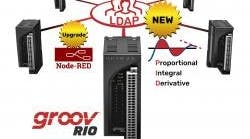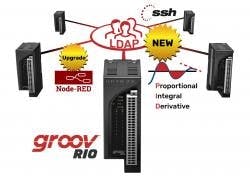Product News: Opto 22’s groov RIO with PID, SSH and LDAP support
groov RIO with version 3.0 firmware
Closely following the initial launch of groov RIO in early 2020, Opto 22 has further expanded the remote I/O, connectivity, and security features of its edge I/O module with the release of its version 3.0 firmware. This version introduces true standalone proportional-integral-derivative (PID) control, thermistor support, and centralized user management via lightweight directory access protocol (LDAP).
PID control is one of the most widely used control methods, applicable to a multitude of process variables, including temperature, pressure, feed/flow rate, position, speed, weight, and concentration. However, traditional standalone and even PLC-based control methods offer little in the way of connectivity or security, which limits their ability to integrate with modern business and industrial networks.
Opto 22’s groov RIO aims to support distributed automation by simplifying the process of specifying, configuring, installing, and communicating remote I/O signals. And in version 3.0, groov RIO gains the ability to independently configure, control, and monitor up to four PID loops—no PLC, PAC, or PC required.
Users can tune loops through groov RIO’s native-management interface using a desktop or mobile web browser and then analyze, combine, or share related process data using other embedded tools like Node-RED and MQTT/Sparkplug B, according to Opto 22. Engineers can choose from any of five analog input types (V, mA, ICTD, TC/mV, thermistor) and two analog output types (V, mA) to design a PID loop strategy. With groov RIO’s software-configurable, multifunction I/O, all channel types are available in a single model and part number, GRV-R7-MM1001-10.
Newly added in version 3.0, thermistor support increases the configurability of groov RIO to over 100,000 unique field I/O combinations. This option includes predefined curves for types 2252, 3K, 10K-2 (CP), and 10K-3 (AN). It also provides a custom curve option that lets the user specify the desired Steinhart-Hart coefficients, per its maker.
To further support distributed automation and industrial internet of things (IIoT) applications, version 3.0 also adds LDAP to the list of already supported IT standards, such as DNS, DHCP, HTTPS, VPN, and MQTT. LDAP-compatible directory servers, like Microsoft’s Active Directory, are the core of user management in many organizations, allowing IT administrators to configure user authentication and authorization across a host of applications. With LDAP support, groov RIO access can be managed by the same system, strengthening security across the organization and reducing the administrative burden associated with scaling up large networks of smart devices.
Secure shell (SSH), another IT standard added in version 3.0, allows for secure remote access to groov RIO’s Linux operating system command line. From there, automation engineers and IT developers alike can use popular programming languages like C/C++, Java, or Python to build custom device interfaces and applications to complement groov RIO’s native integration and edge data processing tools. They can also install third-party applications found in Opto 22’s secure repository, all of which are tested and cryptographically signed by Opto 22 to ensure safe operation with groov RIO.
For current groov RIO users, version 3.0 also includes plenty of incentives to upgrade:
• groov RIO’s backup and restore function now captures the installed Node-RED node library, making it easier to archive, restore, and upgrade without internet access.
• Node-RED also gets an upgrade to version 1.1.3 with improvements to the editor and core nodes, plus support for Websockets connections for data-rich client-side apps.
• The native MQTT/Sparkplug B client now includes integrated logging and enhanced tag properties like deadband, scaled min and max values, and signal filter settings.
• Wireless connectivity is improved with support for the popular Netis WF2190 1200 Mbps long-range USB WiFi adapter.
Obstacles to scalability, like cost, complexity, lack of security, and a gap in critical skills, often hamper investment in the IIoT and remote-monitoring applications. groov RIO addresses these obstacles by providing affordable, flexible, secure industrial I/O connectivity with simple installation and configuration. Version 3.0 adds to the available security and functionality, allowing groov RIO to address an even wider range of automation needs at scale.
Availability
Opto 22’s groov RIO edge I/O module (GRV-R7-MM1001-10) now ships with firmware version 3.0. For current users, version 3.0 firmware is available as a free download from Opto 22.




